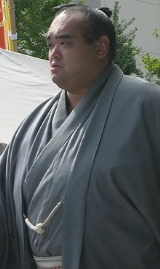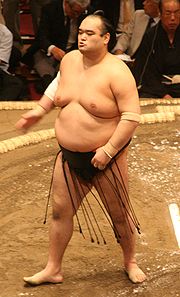
Bushuyama Takashi
Encyclopedia
is a Japanese sumo wrestler from Aomori
, Aomori Prefecture
. He made his professional debut in January 1999. At the age of 32, he was promoted to the top makuuchi
division in the November 2008 tournament. His highest rank has been maegashira 3.
, and reached the round of 16 in the 1998 All Japan Sumo Championship. As his club did not have many members, they regularly trained at Musashigawa stable
, and this was the heya
he joined upon entering the professional ranks. He made his debut in the same tournament as Asashōryū
. He was given special dispensation to begin his career in the third highest makushita division because of his achievements in amateur sumo, but in 2001 fell to the jonidan division because of an elbow injury. He reached the second highest jūryō division in September 2003, the first member of his university to attain sekitori
status.
 In 2005 he fell back to makushita, and did not return to jūryō until January 2007. He won the jūryō division championship for the first time in July 2008, with a 12-3 record. He followed up with a 10-5 score in September. In November 2008, he was finally promoted to the top division. It had taken him 59 tournaments to win promotion to the top division from his debut, which at the time was the longest of any former collegiate champion (this dubious honor is now held by Tsurugidake). At 32 years and five months he was also the fourth oldest wrestler to make his top division debut since the end of World War II.
In 2005 he fell back to makushita, and did not return to jūryō until January 2007. He won the jūryō division championship for the first time in July 2008, with a 12-3 record. He followed up with a 10-5 score in September. In November 2008, he was finally promoted to the top division. It had taken him 59 tournaments to win promotion to the top division from his debut, which at the time was the longest of any former collegiate champion (this dubious honor is now held by Tsurugidake). At 32 years and five months he was also the fourth oldest wrestler to make his top division debut since the end of World War II.
Bushuyama scored eight wins in his top division debut and was promoted to maegashira 6 for the January 2009 tournament. However, a very disappointing 2-13 record there meant he was demoted back to the jūryō division for the March 2009 tournament. He scored 8-7 there, enough for an immediate top division return. He recovered from 1-5 down in May to score 9-6 at maegashira 15. In the September tournament he produced his best top division score to date of 10-5, narrowly failing to win a special prize
after being beaten on the final day. He was promoted to his highest rank to date of maegashira 3 for November 2009. He defeated ozeki Kotomitsuki in this tournament, but recorded a make-koshi score of 6-9. In January 2010 he produced a poor 2-13 record, the same score from the same rank as the previous Hatsu basho in 2009. However on this occasion he remained in the top division for the following tournament, albeit at the very lowest rank of Maegashira 16 West. He lost his top division status after scoring only 4-11 in March, but won his second jūryō championship with an 11-4 record in May and secured an immediate return to makuuchi. In the July tournament he secured his majority of wins on the final day, but he was demoted to juryo again after the November 2010 tournament.
He is a contemporary of Wakanosato and Takamisakari, both also from Aomori.
. His most common winning technique
is yori-kiri (force-out) followed by oshi dashi (push out) and yori-taoshi (force out and down).
Aomori, Aomori
is the capital city of Aomori Prefecture, in the northern Tōhoku region of Japan. As of 2009, the city had an estimated population of 302,068 and a density of 366 persons per km². Its total area was 824.52 km².- History :...
, Aomori Prefecture
Aomori Prefecture
is a prefecture of Japan located in the Tōhoku Region. The capital is the city of Aomori.- History :Until the Meiji Restoration, the area of Aomori prefecture was known as Mutsu Province....
. He made his professional debut in January 1999. At the age of 32, he was promoted to the top makuuchi
Makuuchi
or is the top division of professional sumo. Its size is fixed at 42 wrestlers , ordered into five ranks according to their ability as defined by their performance in previous tournaments....
division in the November 2008 tournament. His highest rank has been maegashira 3.
Career
Bushuyama was a member of the sumo club at Daito Bunka UniversityDaito Bunka University
is a medium-sized four-year university with two campuses: one at Itabashi in Tokyo, and the other at Higashi Matsuyama in Saitama, Japan. The sports program is strong in rugby and marathon running, with the Ekiden team coming 4th in the prestigious January 2009 New Year Hakone Ekiden.Daito Bunka...
, and reached the round of 16 in the 1998 All Japan Sumo Championship. As his club did not have many members, they regularly trained at Musashigawa stable
Musashigawa stable
Fujishima stable is a heya or stable of sumo wrestlers, one of the Dewanoumi group of stables. It was set up on 29 August 1981 by Musashigawa Oyakata, the former yokozuna Mienoumi, who branched off from Dewanoumi stable...
, and this was the heya
Heya
In sumo wrestling, a heya , usually translated into English as stable, is an organization of sumo wrestlers where they train and live. All wrestlers in professional sumo must belong to one. There are currently 49 heya , all but four of which belong to one of five ichimon...
he joined upon entering the professional ranks. He made his debut in the same tournament as Asashōryū
Asashōryū Akinori
is a former sumo wrestler from Ulaanbaatar, Mongolia. He was the 68th yokozuna in the history of the sport in Japan and became the first Mongol to reach sumo's highest rank in January 2003. He was one of the most successful yokozuna ever. In 2005 he became the first man to win all six official...
. He was given special dispensation to begin his career in the third highest makushita division because of his achievements in amateur sumo, but in 2001 fell to the jonidan division because of an elbow injury. He reached the second highest jūryō division in September 2003, the first member of his university to attain sekitori
Sekitori
A sekitori is a sumo wrestler who is ranked in one of the top two professional divisions: makuuchi and juryo.Currently there are 70 rikishi in these divisions...
status.

Bushuyama scored eight wins in his top division debut and was promoted to maegashira 6 for the January 2009 tournament. However, a very disappointing 2-13 record there meant he was demoted back to the jūryō division for the March 2009 tournament. He scored 8-7 there, enough for an immediate top division return. He recovered from 1-5 down in May to score 9-6 at maegashira 15. In the September tournament he produced his best top division score to date of 10-5, narrowly failing to win a special prize
Sansho (Sumo)
Sanshō are the three special prizes awarded to top division sumo wrestlers for exceptional performance during a sumo honbasho or tournament. The prizes were first awarded in November 1947.-Criteria:...
after being beaten on the final day. He was promoted to his highest rank to date of maegashira 3 for November 2009. He defeated ozeki Kotomitsuki in this tournament, but recorded a make-koshi score of 6-9. In January 2010 he produced a poor 2-13 record, the same score from the same rank as the previous Hatsu basho in 2009. However on this occasion he remained in the top division for the following tournament, albeit at the very lowest rank of Maegashira 16 West. He lost his top division status after scoring only 4-11 in March, but won his second jūryō championship with an 11-4 record in May and secured an immediate return to makuuchi. In the July tournament he secured his majority of wins on the final day, but he was demoted to juryo again after the November 2010 tournament.
He is a contemporary of Wakanosato and Takamisakari, both also from Aomori.
Fighting style
Bushuyama favours yotsu-sumo or a grappling style, preferring a hidari-yotsu or right hand outside, left hand inside grip on his opponents mawashiMawashi
In sumo, a mawashi is the belt that the rikishi wears during training or in competition. Upper ranked professional wrestlers wear a keshō-mawashi as part of the ring entry ceremony or dohyo-iri.-Mawashi:...
. His most common winning technique
Kimarite
Kimarite are winning techniques in a sumo bout. For each bout in a Grand Sumo tournament , a sumo referee, or gyoji, will decide and announce the type of kimarite used by the winner...
is yori-kiri (force-out) followed by oshi dashi (push out) and yori-taoshi (force out and down).
Record since year of top division entry
See also
- Glossary of sumo termsGlossary of sumo termsThe following words are terms used in sumo wrestling in Japan. azukari : Hold. A kind of draw. After a mono-ii, the gyōji or the shimpan "holds" the result if it was too close to call...
- List of sumo tournament second division winners
- List of active sumo wrestlers

